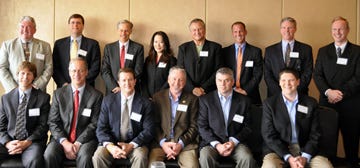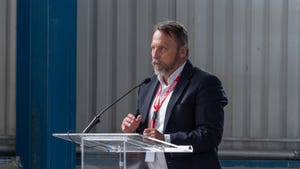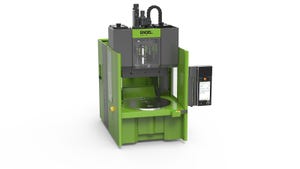Executive Roundtable: How big a bet do you place on onshoring?
In March, PlasticsToday invited 15 industry insiders to discuss the state of the plastics industry.
June 24, 2010
In March, PlasticsToday invited 15 industry insiders to discuss the state of the plastics industry. Highlights of the wide-ranging conversations were presented in a webinar on June 22 (which is available for download). In a follow-up series of articles, we're presenting in-depth accounts of the discussions that took place on various topics: partnering; jobs and skilled labor; onshoring; and the end of "good enough." You can also read our June article on the sessions here (which includes a list of concrete suggestions on what processors need to do to be world-class competitors in the post-recession environment), and our initial NewsFeed report here.
Over the last couple of years, we’ve all been hearing anecdotal accounts of work that is coming back to the U.S. from overseas, whether it’s due to supply chain and quality issues, a lack of supposed savings, or health and safety issues. There seemed to be big savings to be had overseas, particularly in China, but now that we've had some real experience with offshoring, what is the real advantage, and what are the real costs? (See our article on China's cost advantage here, and our article about one's company's decision to pull its molds here.)
So the question is how real is this trend? How big? Why is work coming back? And most important, will it continue?
Here’s what our Roundtable participants had to say on the topic.
|
Rob Neilley (PlasticsToday): What have you been seeing in terms of work coming back to North America? I would never say jobs, don’t think they’re portable that way. You hear about people pulling back molds….What are we hearing? Any feeling your customers are saying people are at least talking to them about it?
Eric Bullivant (Plastrac): People are installing cleanrooms so they can diversify. I’ve seen more cleanrooms over the last year, year-and-a-half…everybody’s trying to get in the medical market that can because it is coming back from China.
Tom Worcestor (Günther Hot Runner Technology): You take the silicone market, and everyone wants to jump into that, but who really knows how to do it, number one, and number two, how big is that market going to be? Everybody’s making this big push, and I just don’t see it as the overall savior of the plastics industry.
Mark Sankovitch (Engel North America): Oh I don’t think it’s the savior, but I think there’s two avenues…one is if you build it they will come—but just because you build a cleanroom it doesn’t mean everybody’s going to come.
The other thing on LSR, that side of it, is when do you buy the stock? Do you buy the stock when it’s at its peak, or at its bottom? The challenge with LSR is where is it. It’s not at the bottom, but it’s not at the topside, either. There are some neat things you can do with it, but it goes back to the two market segments that kind of stay here in North America. Packaging is one, and medical, all we need to do is have more bad chemicals getting into some products that are made in China that scares people, so the medical market’s here and LSR still has some unique things. 

LSR they’re coming out with the new compounds and stuff that opened up that area, where, you know, years ago you couldn’t do two-shot with LSR because you had no reactive sites, today they do. So they’re expanding. But you’re right, you don’t go from themoplastics, say I’m in themoplastics one day, now I want to be in LSR. From all facets—the machines, the tooling, handling the material—that’s the part from the processor standpoint where you’ve got do your due diligence not just say “I’m going to put a cleanroom up, now I’m in medical” and wonder why no one’s coming to beat your door down to give you business.
Christof Heisser (Sigma Plastics): How much of this is caused by high-end requirements versus strength or weakness of the dollar?
Jeff Lewis (Slide Products): Part of it, I get feedback from molders, part of the reason was the ball was dropped. I mean bottles will always stay here—they’re too big to ship from somewhere else so we can have our plastic bottles here.
But a lot of medical parts aren’t so big, so there’s going to be competition on that always because to make 1000 pieces in a box somewhere else that’s only this big, that’s not so much for shipping.
It’s more I think we dropped the ball because a lot of the tooling that’s coming back, and I’m not in tooling—but I pay attention to everything that’s going on because in my job, it’s become more critical to know the whole process because I can’t be a help otherwise—this tooling coming back with mold bases being made out of non-dedicated stock, and problems, and all the different issues some of these guys are facing to re-tool…I know one molder that got 300 molds back, and over 50% of them are junk, and he’s going to have to start from scratch. Yes he’s got the business, but he’s got a whole lot of overhead initially.
I think it’s kind of a combination, we dropped the ball and like I said, what they’re adhering to in the U.S., they’re trying to be pretty strict about these things, which is good. If there’s an area they should be, this is it. I see a lot of guys working feverishly to get these things retooled.
We lost a lot business because of overhead, your cost of manufacturing a pen or fork or whatever, there’s a cost in every part. That’s why a lot of it left, our cost of manufacturing. Do we want to get back to the adjustment? Some countries pay their people $1 an hour for something like that. No, that’s not the type of recovery we’re looking for. We’re looking for going lean and making a better product. We’ve got to be cohesive to get that business back. We can’t compete with what other nations are paying. That’s the slide we’ve been on a long time. Fortunately we’re getting it back because we’re earning it back: overhead’s a big thing.
Bullivant: Regulation as well…Once you scare the American public about not knowing what’s going into your product with lead paint in the toys and things of that nature, the companies are forced to look at other options.
Bruce Catoen (Mold-Masters): We’ve talked for years and years about offshoring, but we’re seeing ‘onshoring’ now. So stuff that is getting repatriated back into countries it left from, quite substantially, where because of a desire to have a high level of confidence in where and how it was manufactured, techniques used, anytime there is any doubt, people are starting to bring them back. Even commodity stuff that we thought we’d never see come back, all of a sudden we find some guy in the middle of nowhere making forks. Wow.
Bullivant: That’s one of our best marketing things, we tout that we’re manufactured in the US. And let me tell you, that has a lot of legs.
Dave Lange (DME): I’d have to agree with you, Bruce. We’ve seen a large amount of tooling come back to the states, some of what we’ve heard is that there’s a lot of dynamics going on in China, you know, rows of moldmakers down the street, you can go from one shop to the next, and it comes down to the sophistication of the North American customer to know how to select the right moldmaker in the Far East and whether or not they’re partnering with the right companies—what kind of tool they’re eventually going to get, either to run in China or come back to the States, and we’ve seen that dynamic change in the last year, particularly where there’s a lot of sensitivity at the OEM level with the timeliness of a project—too many trips, it’s too expensive to fly, they’re getting sick of flying coach, and what are we actually saving.
What’s the real cost when this project now is not going to be on time, not going to run the production we need, and now we’re shut down and replacing some of the steel inserts because they’re not of the integrity we originally thought we were going to get? There’s a lot of demand on companies like ourselves who have standardized, who work with customers in the Far East, and because of the sensitivity of the impact it has on the end part, and the relationship between molders and their customers, we’ve seen an increase in business for that reason. The dollar helps, but that was going on a year ago while we were in this recession, so I think it’s got some legs.
Mark Molloy (Progressive Components): Yeah, we’re hearing some of that. The question is what’s coming back, what’s going back, and what’s the difference. I heard someone say to us, a contract molder in Asia, that America is now becoming a low-cost country. The cost of tooling is coming down, through automation, to moldmakers getting more streamlined, even the molding process itself. We’re hearing about things coming back.
Sankovitch: We’re seeing some as well, some is coming back, but you can’t get too optimistic about it because it’s where what comes back here there’s going to be a trend to bring all this back. That’s a false sense of thinking where we’re going to go.
The challenge I think, what becomes challenging, is how do I size my business for the market, where’s the market going to be, and the challenge I know that we have is how big go you get? How elastic can your company be? To basically say, if some of this stuff comes back can I expand enough with or without having to add people?
That to me is a big challenge if some of this stuff comes back—how much elasticity is built in, because nobody wants to hire full-time people if they’ve got to lay them off in a month, five months. Hopefully as we move forward everybody in this room doesn’t have to lay people off anymore and we can start to build from that. But once again, the challenge comes to how do you build from that, how elastic can you be? We do see some coming back but not in a sustainable manner that we can say I’m going to start increasing my infrastructure for that coming back.
Rob Neilley: Any upturn in the domestic work that’s still here? If there’s been this pickup, where’s it coming from?
Dave Preusse (Wittmann Battenfeld): There’s still some people who have a successful business recipe as injection molders, and they have had even when there was a downturn, they know what they’re doing. There’s actually not a lot of it, but we’ve seen some customers do what they do and they’re actually exporting quite a bit and they’re expanding their factories.
I think they’ll continue to do very well, and even better now with the recovery. There’s others out there that aren’t retooling…certainly I think everybody would agree at this table there’s a going to be a component of reinvestment and replacing the old machines. We just went through a recession, they weren’t spending the money, the pent-up demand is a good point that might be a little bit of the spark we’re seeing now, could flatten in the summer, yes, there was some year-end money, but not much, so now are people really going to replace some of those older machines, and are they going to invest in the automation or whatever?
Well, I think some of the molders who weren’t doing that before are going to be still slow to do it and they’re going to feel more pain, and others who are jumping in with both feet I think they’ll do fine. There’s plenty of work here. Others countries would give their right arm to have the number of cars we have sold in this country. Yes, it’s down, but still the auto sector is huge. And there’s so much to be done with all the different technologies the suppliers offer. So I think there’ll still be a very good market. There’ll be more shake-outs, and that’s another tough part of our business is the turns, people talking about all the things we’re supposed to do to protect ourselves. We still get invited the big auto guys to get asked “We want to look at your financials and give you the rubber stamp” and we all want to say, “Can we look at your financials?”
Larry Doyle (The Conair Group): You all touched on some of the markets that continued to grow in ’09, recession-proof to an extent. Packaging continues to be a strong market and is one that continues to have demand for new equipment, and in some instances there are some packaging molders, PET preforms for example, that demand technology, that demand not just technology but performance, and they’re willing to invest, they have the money to invest. And medical, medical extrusion for us has been gangbusters throughout ’09—they’ve got a demand, high technology, and it’s something they’re willing to pay money for. They’ve got to make those investments because of the regulations they face. —John Clark
About the Author(s)
You May Also Like



